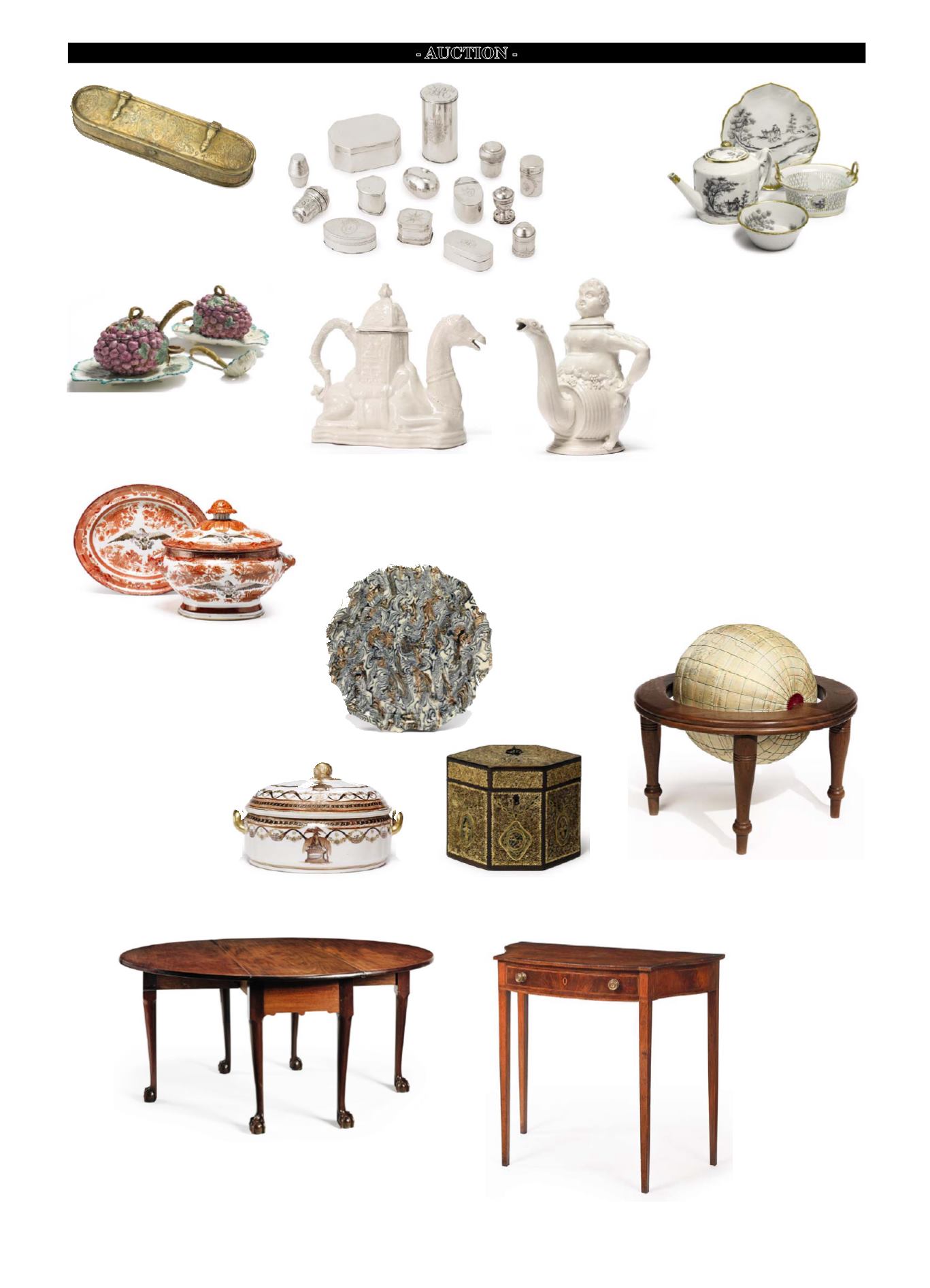

20-B Maine Antique Digest, April 2015
- AUCTION -
Continental
brass
traveling
writing set, Dutch or
German, dated 1594, a compart-
mented interior with a removable inkwell
and sander, the hinged cover engraved
with arms, date, and a vase of flowers,
$4375 (est. $800/$1200) to an absentee
who left a bid with the auctioneer.
Pair of English enameled creamware grape-
form tureens on fixed stands, with covers and
ladles, late 18th/early 19th century, naturalis-
tically modeled on 8" long leaf-shaped stands
raised on three rosette feet, with pierced ladles—
six pieces in all—$5000 (est. $2500/3500).
Chinese export porcelain orange Fitzhugh oval soup
tureen, cover, and 14½" long stand, 1810-20, each
piece painted on either side or in the center with a
brown eagle emblazoned with a shield enclosing a
bouquet of flowers, clasping in its talons a brown lau-
rel branch or a cluster of gray arrows, bearing in its
beak a rose banderole inscribed “E Pluribus Unum,”
and surrounded by characteristic clusters of flow-
ers and precious objects, $40,625 (est. $8000/12,000).
Ruth Nutt bought it from Hirschl & Adler Galleries
in 2004.
A varied collection of
14 nutmeg graters, 18th
and 19th centuries, the
tallest 3 1/8", $4688
(est. $4000/6000). Most
were made in London
or Birmingham, but
one was Chinese export
and another from India,
circa 1920.
Group of Chinese export porcelain table-
ware in the “Quaker Farmer” pattern, circa
1810, comprising a teapot and cover, a 10"
long shell-shaped dish, a chestnut basket,
and a dessert bowl, all painted
en grisaille
with a man beside his cow in a bucolic farm
landscape, within gilt borders, $31,250 (est.
$4000/6000).
The “Quaker Farmer” design is found
executed in polychrome, green enamel,
sepia, and gray and is closely associated
with the Morris family of Philadelphia. A
drawing of this subject—ascribed to Mary
Hollingsworth Morris (1776-1820), who
has long been believed to be the design
source of the Chinese export wares—
survived in the family and is now at Dumbar-
ton House, headquarters of the Colonial
Dames of America. Mary’s husband, Israel
Morris (1778-1870), was an investor in the
China trade, along with several of his broth-
ers, and numerous examples of “Quaker
Farmer” wares have survived within differ-
ent branches of the family.
For more information, see Brian J.
Lang’s
From East to West: “Quaker Farmer”
Chinese Export Porcelain in America
(
2006).
Staffordshire white salt-glazed stone-
ware camel-form teapot and cover,
circa 1745, 5 1/8" high, the recumbent
beast wearing elaborate trappings sup-
porting a howdah molded with Chi-
noiserie scenes, $5938 (est. $5000/7000).
In 1990 this rare circa 1760 Staf-
fordshire white salt-glazed stone-
ware “Bacchus on a Barrel” teapot
and cover, 6¼" high, with his left
arm bent to form the handle and
his head the cover, had been bought
by British ceramics dealer Jona-
than Horne at the famous “Rous
Lench Collection” sale at Chris-
tie’s in London. At Sotheby’s sale
of the Nutts’ collection, it sold for
$13,750 (est. $5000/7000) to London
dealer by Garry Atkins in the room,
underbid by New York City dealer
Alan Kaplan.
Rare silk embroidered terrestrial globe,
stitched by Mercy Smedley, Chester County,
Pennsylvania, early 19th century, silk with
ink inscriptions identifying the continents
and oceans, and mounted in a turned cherry
base, overall height 8", the globe 5¼" diam-
eter, $13,750 (est. $800/1200) to a bidder on
the phone. Mercy Smedley of
Oxford, Pennsylvania, was a
student at Westtown School.
A similar work in the collec-
tion of the Los Angeles County
Museum of Art, worked by
Lydia Satterthwaite (b. 1803)
of Chester County, Penn-
sylvania, and dated 1817, is
illustrated and discussed in
Edward Maeder’s
600 Years
of Embroidery from the Per-
manent Collection, 1380-1980
(Los Angeles County Museum
of Art, 1982). Another exam-
ple of terrestrial and celes-
tial globes, worked by Sarah
R. Sheppard, 1844, is illus-
trated and discussed in Betty
Ring’s
Girlhood Embroidery
(1993).
Federal
mahogany
serving table with an
old surface, North
Shore of Massachu-
setts, circa 1800, 32½"
x 36" x 18¼", ex-Israel
Sack, Inc., $22,500
(est. $4000/6000) to a
phone bidder.
George III rolled paper hexagonal-
form tea caddy, last quarter 18th
century, 5½" tall x 7¼" wide x 4½"
deep, $1250 (est. $1500/2000).
Rare Staffordshire
agateware silver-shaped
salver, circa 1750, raised
on three hoof feet, 6" diame-
ter, $6875 (est. $4000/6000).
Chinese export porcelain Washington memorial three-
part vegetable tureen and cover, 1800-02, 11"
long, painted in brown monochrome with
a spread-winged eagle perched on a
monument inscribed “Washington”
within an oval on its base, and an
oval panel monogrammed “JRS”
in iron-red and gold, set within a
band of gold and brown flower-filled
drapery entwined with a gilt flower-
ing vine, $40,625 (est. $7000/10,000).
Ruth Nutt bought it from Hirschl &
Adler Galleries, New York City, in 2003.
In October 2000 one sold for $3600 at Sotheby’s auction
of the Mottahedeh collection.
Carved and figured mahogany six-legged
drop-leaf dining table, New York, circa
1770, 28½" high x 55" deep, 63" wide
when opened, 21½" wide when closed,
ex-Israel Sack, Inc. (1980), $28,125 (est. $30,000/50,000) to a collector in the salesroom. “The
oval top with drop leaves hinged on cylindrical fulcrums attached to the center board; the frame
supported by four turned tapered legs ending in squared ball-and-claw feet, a swing leg on each
side with turned tapered legs ending in squared ball-and-claw feet, the apron at each end has
cyma scrolled brackets and center nodule,” according to the catalog.










